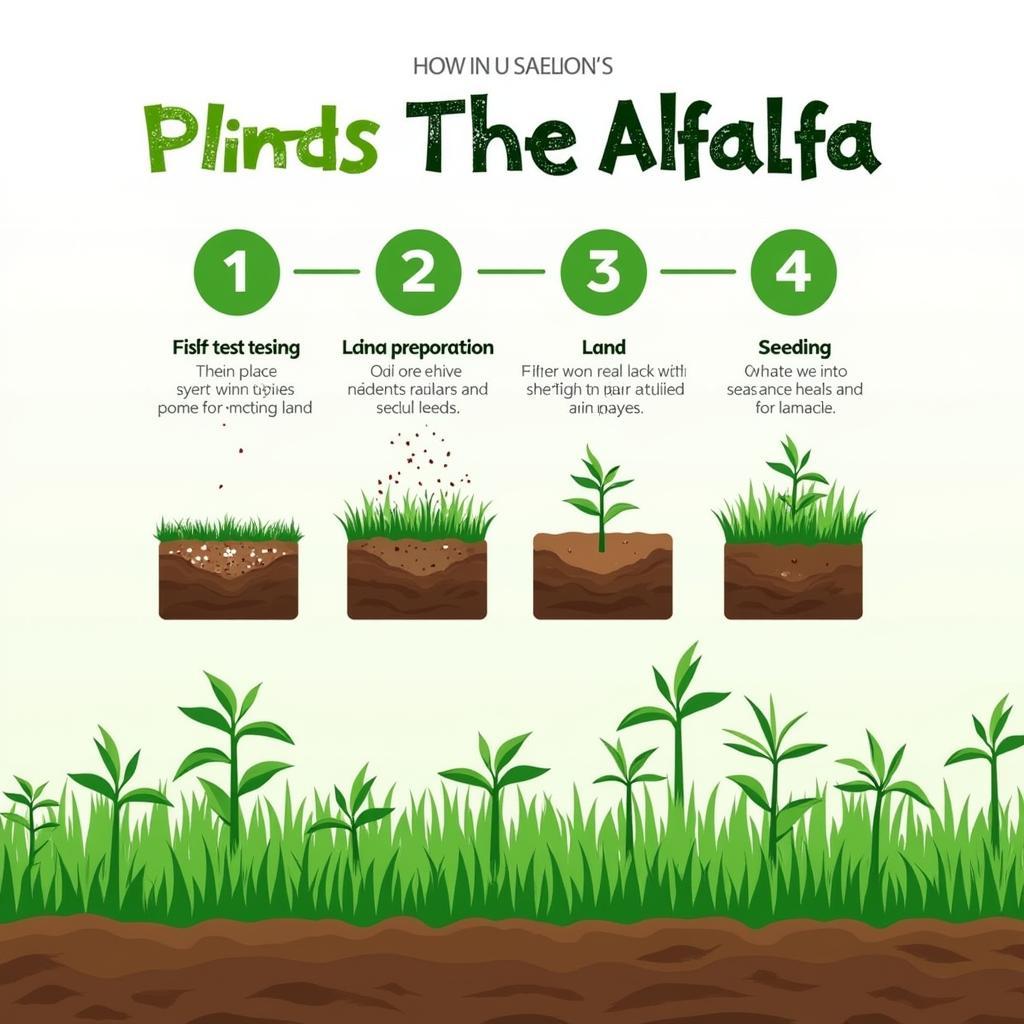Alfalfa For Food Plots offers a highly attractive and nutritious option for wildlife, especially deer. Understanding its benefits, planting process, and management is crucial for success. Let’s dive into the world of alfalfa and discover how it can transform your food plot strategy.
Planting wildlife food plot seed is an important part of attracting deer to your property. Alfalfa offers many benefits over other types of food plots and can help provide the nutrition deer need to thrive.
The Benefits of Alfalfa for Wildlife
Alfalfa stands out as a top-tier food plot choice due to its high protein content, appealing palatability, and longevity. This perennial legume provides consistent forage for several years, making it a cost-effective option for landowners. Its deep root system also improves soil health by fixing nitrogen, leading to healthier soil for future plantings. Alfalfa is a highly digestible forage, providing essential nutrients for deer growth and antler development. It’s especially beneficial for fawns and does during lactation.
What makes alfalfa so special? Its nutritional powerhouse status, combined with its persistence and soil-improving qualities, makes it a true winner in the food plot game.
Planting and Maintaining Your Alfalfa Food Plot
Successfully establishing an alfalfa food plot requires careful planning and execution. Soil testing is paramount, as alfalfa thrives in well-drained soils with a pH between 6.5 and 7.5. A soil test will inform necessary amendments, like lime, to achieve optimal pH levels.
Site preparation involves thorough weed control, either through tillage or herbicides. A firm seedbed is essential for good seed-to-soil contact. Seeding rates typically range from 15-20 lbs per acre. Optimal planting depth is about ½ inch. Inoculating the seed with the correct rhizobium bacteria is crucial for nitrogen fixation.
 Alfalfa Planting Process
Alfalfa Planting Process
Maintaining your alfalfa plot involves regular mowing to control weeds and encourage vigorous growth. Fertilization is also important, especially after the first cutting, to replenish nutrients. Alfalfa is also drought-tolerant once established, making it suitable for areas with limited rainfall.
If you’re looking for the best food plot for deer, alfalfa is a great option. It can provide the nutrition deer need throughout the year and is relatively easy to maintain.
Common Challenges and Solutions
While alfalfa offers many advantages, it does come with some challenges. Weed competition during establishment can be a significant hurdle, so thorough weed control is essential. Pest and disease issues can also arise, so regular monitoring is vital.
Another challenge is the cost of establishment, which can be higher than other food plot options. However, its longevity offsets this initial investment. Finally, alfalfa is not shade-tolerant, so choose a sunny location for your plot.
Implementing a good food plot design for deer can maximize the effectiveness of your alfalfa plot. Proper placement and size can help attract more deer and keep them on your property.
“Alfalfa is a long-term investment in your land and wildlife,” says Dr. Sarah Miller, wildlife biologist. “Its ability to improve soil health while providing high-quality forage makes it an invaluable tool for habitat management.”
Maximizing the Impact of Your Alfalfa Food Plot
Consider implementing no-till food plots for deer when using alfalfa to minimize soil disturbance and improve soil health. This can enhance the long-term benefits of alfalfa for your land.
To optimize the benefits of your alfalfa plot, consider its placement within your overall property layout. Strategic placement near bedding areas or travel corridors can increase deer usage. Creating a diverse food plot strategy by incorporating other forage varieties can further enhance your property’s attractiveness to wildlife.
“Diversity is key in any food plot strategy,” adds Dr. Miller. “Combining alfalfa with other forages creates a balanced diet for deer and can attract a wider range of wildlife.”
 Deer Grazing in an Alfalfa Field
Deer Grazing in an Alfalfa Field
Choosing the right perfect 10 food plot seed blend can complement your alfalfa plot and further enhance its effectiveness. This can provide a well-rounded food source for deer and other wildlife on your property.
Conclusion
Alfalfa for food plots presents a powerful tool for attracting and nourishing wildlife, particularly deer. While it requires careful planning and management, the long-term benefits of improved soil health, high-quality forage, and increased wildlife activity make alfalfa a worthwhile investment. By understanding the specifics of alfalfa cultivation and incorporating it strategically into your food plot design, you can create a thriving habitat that benefits both the land and its inhabitants.
FAQ
- What is the ideal soil pH for alfalfa? (6.5-7.5)
- What is the recommended seeding rate for alfalfa? (15-20 lbs per acre)
- How deep should alfalfa seeds be planted? (About ½ inch)
- How long does an alfalfa stand typically last? (Several years)
- What are the main benefits of alfalfa for deer? (High protein, palatability, and longevity)
- What are some common challenges with alfalfa food plots? (Weed competition, pests, and diseases)
- How can I maximize the impact of my alfalfa food plot? (Strategic placement, diverse planting, regular maintenance)
If you need further support, please contact us at Phone Number: 02437655121, Email: minacones@gmail.com, or visit us at 3PGH+8R9, ĐT70A, thôn Trung, Bắc Từ Liêm, Hà Nội, Việt Nam. We have a 24/7 customer support team.